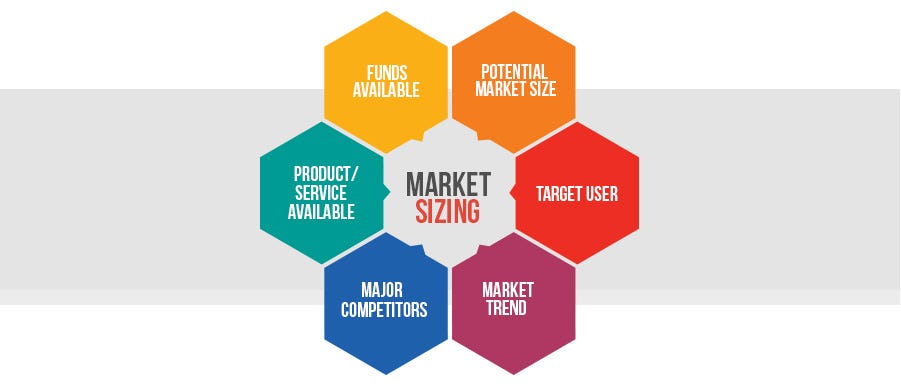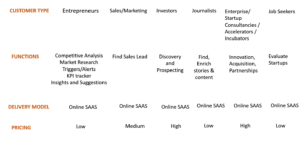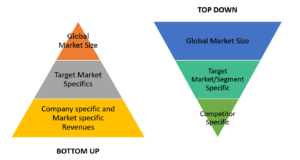Is A Market Sizing Template By Segment Or By Product
Marketplace Sizing Techniques

What is a Market?
Many first-time Entrepreneurs struggle with defining a 'Marketplace'.
A market is a mechanism through which a company delivers and sells a product/service to their customers.
Eg:
- B2C: If you lot are ownership raw material from say x companies and selling a packaged product to 10,000 users, then those 10,000 users are your target marketplace.
- B2B: If you are collecting data from 10,000 users and selling data to x companies, then those 10 companies are your target market place.
In that location perhaps Multiple Markets for the product Service. See Customer Sectionalisation Model to place those markets.Identify the Customer Blazon and Functions they would use the production for and try building a model like this:

What is Market Sizing?
Always idea/heard questions like:
- How large is the used mobile phone market place in India?
- What is the market opportunity if you introduce a new clothing line in Bharat?
- What is the marketplace opportunity of launching a cab aggregator in Bharat? How did Jugnoo grow against Uber/Ola in India?
Market Sizing is a method of evaluating the potential achieve and revenue of your production/service.
Marketplace Sizing is Divided broadly into 4 Categories:

1. Marketplace Potential:
Bold 100% market Share, the total potential value of product/service sold over a specified timeframe.
2. TAM (Full Addressable Market):
The potential value of Product/Service sold to a particular customer segment.
three. SAM(Serviceable Available Market):
The total value of Product/Service that can fulfill the demand of a segment using a ane revenue stream/channel.
four. SOM(Serviceable Obtainable Market):
The total value of SAM divided by the expected percentage market share that the company tin capture.
Why is information technology Important?
- Quantify the sales or profit potential of new product markets or customer segments.
- Identify production lines and client segments with lucrative growth opportunities.
- Helps validate Business organisation Model hypothesis.
- Specify competitive threats and develop strategic responses to those threats.
- Develop get out strategies or pivot points for the future.
- Important to Investors: They want a scalable production addressing a large enough market to get the almost blindside for their bucks. Listen to them.
How to use Market Sizing:
First, let's ascertain the Quantifiable Values that we are looking for:
- Value: Total value of clients/products in the market.
- Units: Total Number of clients/products in the market place
- Market Share: % of clients/products acquired/sold by your competitors vs total value/units.
Market Sizing Approaches:
- Top Down: This type of sizing is done generally by using Demographical data similar Visitor size, industry, location or Human Population, Age, Income etc. Base of operations your hypothesis on a big number and work your way down from at that place. You can segment the market place the way it best suits the business.
- Bottom Up: Place the Micro segment or the niche marketplace you are targeting and extrapolate the numbers till you attain an appropriate scale. Eg: Calculate how much an average person spends a twenty-four hours in the part cafeteria, and now multiple it by the number of employees and number of working days in a month/year.

For both approaches, include price at the concluding step. We recommend using both methods to try to solve the trouble. Both approaches might produce unlike results, but in general, they should be close enough to triangulate on a more accurate answer.
Marketplace Sizing Techniques:
- Production Market place Analysis:
Working Excel model here. - Market Sizing using StartupFlux: (Video Demo coming soon)
– Piece the market using Location (metropolis, country, country, continent)
– Select an Industry
– Select a value concatenation eg: manufacturing
– Add more data points: similar the number of employees or social stats
– Get the Number of Companies matching the criteria - Spending Data:
Research firms and analysts publish numbers on how much companies/people spend on production/services over time. - Census Statistics:
Authorities and public/private companies publish a lot of information about customer demographics, list of registered companies etc that can exist used to estimate the market size. - Market Projections:
Consider the estimated growth rate of the vertical/segment to identify if it is growing or declining. This would requite a rough idea of how hard or like shooting fish in a barrel the market could be to penetrate. Google Search for market place analyst, enquiry, and consulting business firm estimates to get reliable numbers.
Marketplace Sizing is important to confidently answer several key questions that a business needs. We hope that these approaches and techniques help identify the right target market and price indicate.
Permit us know if nosotros can help in any way. Comment below or drop us an email. Happy to aid.
Is A Market Sizing Template By Segment Or By Product,
Source: https://medium.com/think-with-startupflux/market-sizing-techniques-170bcd5689f6
Posted by: emmonsblem1983.blogspot.com


0 Response to "Is A Market Sizing Template By Segment Or By Product"
Post a Comment